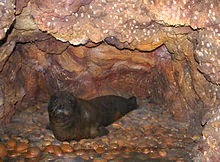 |
| Barbary Ground Squirrel (Fuerteventura) |
Volcanic islands far from the mainland often have no native
terrestrial mammals aside from bats, but the Canaries prior to the arrival of
humans had several native terrestrial mammals, and were also almost certainly a
breeding site for the Mediterranean Monk Seal, a few of which still breed on
the North African coast.
 |
| Canary Shrew |
Today the only native mammal to still survive is the Canary
Shrew Crocidura canariensis, which
occurs on Fuerteventura and Lanzarote. It is adapted to arid terrain, and
shelters in lava tubes during the day. The main modern threat is probably
fragmentation of populations as a result of tourist development, with possible
predation by feral cats (Fuerteventura swarms with them). A second species of
shrew, the related Greater White-toothed Shrew C.russula is found on Grand Canaria, but is an introduced species.
Another introduced species, the Etruscan Shrew Suncus etruscus, is found on Tenerife.
 |
| Algerian Hedgehog |
The introduced shrews are probably
not much of a threat to the endemic insects, but rather more serious is the
North African Hedgehog Atelerix algirus,
which is introduced to several of the islands, although it seems most
widespread on Fuerteventura and Lanzarote. Introduced European Hedgehogs have
proved serious threats to nesting seabirds on islands in the UK, and it is
noteworthy that most of the seabirds breeding in the Canaries are now found
mainly on small islets rather than the main islands.
 |
| Gambian Pouched Rat (doing mine clearance !) |
Rodents arrived from Africa some time in the distant past on
at least two occasions. Tenerife and La Palma were home to a species each of
Canariomys, large rodents the size of the Gambian Pouched Rat shown here. The
native rodents seem to have been generalists, with bodies adapted to both
climbing and digging, and probably inhabited the laurasilva forest. They did not
last long after the arrival of humans, although whether they were actively
hunted or succumbed to the islanders’ dogs is not clear. A much smaller
species, the Lava Mouse Malpaisomys lasted much longer in the eastern islands,
and probably fell victim to Spanish cats. Malpaisomys seems to have been
nocturnal judging from its large eyes, and was about twice the size of a house
mouse, to which it was fairly closely related. Whether it preyed on seabird
chicks like the introduced house mice on Gough Island in the South Atlantic
(which have already evolved to a size similar to Malpaisomys) is not clear, but
its teeth seem to have been adapted to a plant based diet. On the eastern
islands today the most visible rodent is the introduced Barbary Ground Squirrel
Atlantoxerus getulus, which was introduced as a pet in 1965 and has now overrun
Fuerteventura. How much effect this has had on other animals is unclear – they squirrels
are prey for buzzards, kestrels, and of course the cats but may themselves prey
on eggs and nestlings of ground nesting birds on occasion. As these birds are
the same species that live alongside the ground squirrels on mainland Africa,
they probably have reasonably good nest defence against squirrel predation. In
addition to rodents, rabbits have also been introduced to the islands, and are
an important element in the local cuisine.
 |
| Kuhls Pipistrelle |
Today eight species of bats can be found in the islands. The
only endemic species is the Tenerife Long-eared Bat Plecotus teneriffae, although the Madeira Pipistrelle Pipistrellus maderensis is endemic to
Macaronesia, being found on Madeira and the Azores as well as the Canaries.
Kuhl’s Pipistrelle P.kuhlii (shown
here) is a southern European species that is spreading north and is now
breeding in Jersey and possibly on the south coast of England, and also breeds
on the islands.
 |
| Common Dolphin |
A huge variety of cetaceans may be seen in Canarian waters
up to and including Blue Whale, but the commonest species seen are Short-Finned
Pilot Whale Globicephala macrorhynchus or Short-Beaked Common Dolphin Delphinus
delphis. Finally, on rare occasions
Mediterranean Monk Seals still are seen, strays from Madeira or the North
African coast, where there are a few small colonies.
 |
| Mediterranean Monk Seal |
It has taken a long time to get this far, but next time I
can finally start on covering the birds seen on the trip, starting with the
various aquatic birds seen on reservoirs and the sea on the various islands.
(Barbary Ground Squirrel photo is mine, rest from wikipedia)
No comments:
Post a Comment